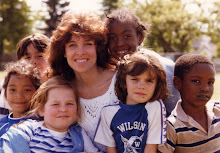Nick's interest was clearly piqued by food, in part because his dad works in the restaurant industry. His passion lead me to schedule a gnocchi-making lesson with Aunt Izzy, a legend
 at the Batali family outpost, Salumi. Here they are working together, along with a second photograph Nick took during Izzy's lesson. (She was a great teacher, so I wasn't surprised to find out that she had taught kindergarten for many years!)
at the Batali family outpost, Salumi. Here they are working together, along with a second photograph Nick took during Izzy's lesson. (She was a great teacher, so I wasn't surprised to find out that she had taught kindergarten for many years!)
Nick wrote out the ingredients, and I later helped scribe the instructions in his own words. Just this week, two years after that lesson and several months after Izzy sadly passed away, Nick came over to make gnocchi. We took out his recipe and followed it again.
Aunt Izzy’s Gnocchi
By Nick 1/07
By Nick 1/07
INGREDIENTS
500 grams potatoes (approximately one pound)
300 grams flour
2 eggs
2 t. salt
Your favorite sauce
Parmigiano Reggiano cheese
Serves 4-6
DIRECTIONS
1. Put the potatoes in a large pot of boiling water. We used Yukon Gold potatoes. Cook until they are tender. Cool and peel them while they are still warm.
2. Put another large pot of water on to boil while you make the gnocchi. Put the sauce on the stove to warm at the same time.

3. Press the potatoes through a ricer onto a clean counter covered with a little bit of flour. Add the flour and salt so it makes a mound and then make a hole in the middle. Crack the eggs into the hole.
4. Start to stir with your fingers mixing in the flour and potatoes and if you think it is soft enough, make it in
 to a ball and knead it until it’s smooth. Leave it alone for 5-15 minutes.
to a ball and knead it until it’s smooth. Leave it alone for 5-15 minutes.
5. Flatten the ball and cut the flattened side into 6 strips (or so).
6. Make sure you have just a little flour on the table or counter. Roll one of the strips like a snake until it’s about as big around as your thumb. You might have
 to break it into two or three pieces as it gets longer. It helps to spread your fingers out as you roll it.
to break it into two or three pieces as it gets longer. It helps to spread your fingers out as you roll it.7. Take a knife and don’t saw it, cut the snakes into pieces about as big as the length of your finger from the first knuckle to the tip, or a little more than half an inch. The flour on the table should keep the gnocchi from sticking together but don’t use too much.

8. Roll the gnocchi on a fork or a gnocchi board to make the ridges. Izzy likes to make ridges on the gnocchi because the sauce sticks better. You roll it with your thumb making a little impression in the middle. It takes practice and some people are better at it than others.
9. Put the pieces onto a tray with about 3-4 tablespoons of cornmeal so t
 hey don’t stick together.
hey don’t stick together.10. When the water is boiling, put half of the gnocchi in the pot. The gnocchi will sink to the bottom and then float to the top. After it floats to the top, cook it for one more minute. Then scoop it out into a colander to drain and do the same thing to the rest of it.
11. Serve the gnocchi in warm bowls with a couple spoonfuls of sauce. Grate the cheese over the top.

12. EAT IT!
I can't think of a better homework project--a solid hour+ of work--for a kid who was once described as lacking focus. What interests the kids in your life? How could you use reading, writing, sketching, and photography to learn more?








